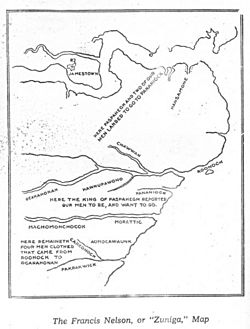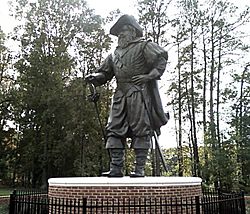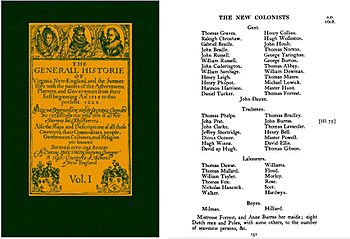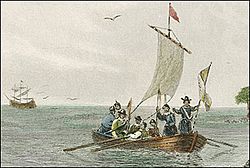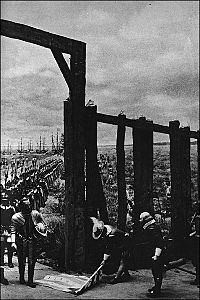Jamestown supply missions facts for kids
The Jamestown supply missions were a series of fleets (or sometimes individual ships) from 1607 to around 1611 that were dispatched from England by the London Company (also known as the Virginia Company of London) with the specific goal of initially establishing the Company's presence and later specifically maintaining the English settlement of "James Fort" on present-day Jamestown Island. The supply missions also resulted in the colonization of Bermuda as a supply and way-point between the colony and England.
The Jamestown colonists initially chose the fort's location because it was favorable for defensive purposes. Although some of them did some farming, few of the original settlers were experienced farmers, and as hunters they quickly exhausted the area's supply of small game. To make matters worse, the most severe drought in 700 years occurred between 1606 and 1612. Consequently, the colonists quickly became dependent upon trade with the Native Americans and periodic supply from England for their survival. Captain Christopher Newport was tasked with the duty of leading the first three re-supply missions back to Jamestown. However, it was not until a fourth mission under Lord Thomas West that the settlement was finally able to establish both defensive and food security.
Contents
Original mission
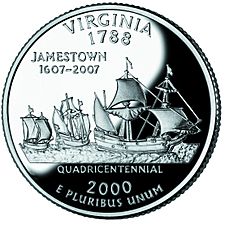
The London Company organized a for-profit expedition to establish a settlement in the Virginia territory in late 1606. The expedition consisted of three ships, which set sail on December 20, 1606 from Blackwall, with 105 men and boys and 39 crew-members. There were no women on the first ships.
The ships in this fleet were:
- Discovery, 20 tons, with Captain John Ratcliffe and 21 people
- Godspeed, 40 tons, with Captain Bartholomew Gosnold (serving as vice-admiral) and 52 people
- Susan Constant - sometimes known as Sarah Constant - (flagship), 120 tons, with Captain Christopher Newport and 71 people
Voyage
The fleet headed south-west towards the Azores. Early in the voyage, on February 13, 1607, near the Canary Islands, Captain John Smith was charged with mutiny, and Newport had him arrested and planned to execute him upon arrival in the Caribbean (and later in Virginia). Passing Martinique on March 23, they also visited Dominica, on March 28, Nevis, and St. Croix, where they replenished their water and food. By April 6, 1607, the fleet arrived at the Spanish colony of Puerto Rico, where they stopped for provisions before continuing their journey. They landed on Mona and Monito Islands on April 7, and left on April 9, the last stop before the mainland.
After an unusually long voyage of 144 days, and the death of only one passenger, they made landfall on April 26, 1607 at the southern edge of the mouth of what they named the James River on the Chesapeake Bay. A party of men then explored the area and had a minor conflict with some local "Indians", so the colonists moved north. On May 14, 1607, they finally chose Jamestown Island (at that time a peninsula), further upriver and on the northern shore, for their settlement, as it was a location that could be easily defended from attacks by other European states, notably the Dutch Republic, France, and Spain.
However, after the long voyage, their food stores were sufficient only for each to have a cup or two of grain-meal per day. Further, the worst drought in 700 years occurred in the area between 1606 and 1612, affecting the Jamestown colonist and local Powhatan tribe's ability to produce food and obtain a safe supply of water. In addition to settling, the early colonists were expected to make a profit for the owners of the Company. The early settlers were excited by the apparent availability of gold, and from the outset settlers attempted to produce timber for export, given the seemingly inexhaustible supply within Virginia's virgin forests. However, they could not devote much time to developing commodity products, as they were too busy trying to survive. On June 22, 1607, Newport sailed back for London with Susan Constant and Godspeed carrying a load of supposedly precious minerals, leaving behind the 104 colonists and Discovery (to be used in exploring the area).
John Smith (1607)
Using the ship left to the colony, Smith undertook three exploratory voyages of the Chesapeake Bay and along the various rivers seeking a supply of food for the colonists in June, July, and August 1607. However, while leading one food-gathering expedition in December 1607, this time up the Chickahominy River west of Jamestown, his men were set upon by Pamunkey natives, and Smith was captured. After being "saved" by Pocahontas, Smith returned alone to Jamestown just in time for the "First Supply", in January 1608.
First supply mission
Arriving back in London on August 12, 1607, Newport delivered a letter from the council alongside his cargo of "gold" (which was quickly determined to be iron pyrite). He was then put in charge of the urgently needed re-supply mission, containing a few provisions and more than 70 new colonists.
The ships were:
- John and Francis with Captain Christopher Newport
- Phoenix with Francis Nelson
Voyage
The first re-supply fleet, tracing the same route as the original fleet, arrived at the colony on January 2, 1608. Upon his return, Newport found that the effects of the lack of planning and lack of skills amongst the original colonists, combined with Powhatan attacks, had quickly reduced the original settlement to only 38 survivors. However, despite replenishing the colony's supplies, the two ships also brought an additional 120 men (settlers and crew), as recorded later by Smith.
This proved troublesome, particularly when a few days later the fort caught fire, destroying most of the existing buildings, food, and supplies. Despite their original intention to grow food locally and trade with the local natives, the barely-surviving colonists became increasingly dependent upon external supply missions. After expanding fortifications, rebuilding shelters, and placing armed men to defend crops from native attacks, Newport felt he had sufficiently re-secured the settlement by the end of winter. Accordingly, he departed again for England on April 10, 1608, with another cargo of "gold". In his absence, the meagre food supplies quickly ran low, and although Native Americans brought some food, Smith wrote that "more than half of us died".
John Smith (1608)
Smith ventured into the Chesapeake Bay twice more in 1608, in the months between the first and second supply missions, charged by the Company to search for gold and a passage to the Pacific Ocean. The first trip lasted from June 2 to July 21; a second, longer expedition spanned July 24 to September 7. Searching for badly needed food, he covered an estimated 3,000 miles (4,828 km), producing a map (see image) that was of great value to local explorers for more than a century. This time he successfully traded for food with the Nansemonds along the Nansemond River, and several other groups. He had mixed results dealing with the various other tribes, most of whom were affiliated with the Powhatan Confederacy. These explorations were later commemorated in the Captain John Smith Chesapeake National Historic Trail, established in 2006.
Second supply mission
Newport and the ships arrived back in London on May 21, 1608, and despite another disappointment with false gold, an additional re-supply trip was quickly organized. Urgently needed supplies and 70 new settlers (see list below) were gathered, including Thomas Graves, Thomas Forrest and Forrest's wife "Mistress Forrest and Anne Burras her maide" (the first women known to have come to Jamestown).
Also included were the first non-English settlers. The Company recruited these as skilled craftsmen and industry specialists: soap-ash, glass, lumber milling (wainscot, clapboard, and ‘deal’ — planks, especially soft wood planks) and naval stores (pitch, turpentine, and tar). Among these additional settlers were eight "Dutch-men" (probably German or German-speakers), Polish and Slovak craftsmen, who had been hired to help develop and manufacture profitable export products. William Volday (Wilhelm Waldi), a Swiss German mineral prospector, was also among those who arrived in 1608. His mission was seeking a silver reservoir that was believed to be within the proximity of Jamestown. Some of the settlers were the artisans who built a glass furnace which became the first factory in America.
The ships were:
- Mary Margaret with Captain Christopher Newport
Passenger manifest
A passenger manifest of those in the second fleet was recorded, in Volume 1 of The Generall Historie of Virginia, New-England, and the Summer Isles by Captain John Smith, published 1624.'
Voyage
Newport's instructions were to search for any survivors of the Lost Colony of Roanoke, resume exploring for gold mines, and stage a "coronation" of Powhatan, making him a "sub-king" under James I. On October 1, 1608 the supply ship arrived following a journey of approximately three months. Following his orders, Newport searched for the Lost Colonists and gold mines, and attempted a coronation, all without success.
He then returned to England, this time not with iron pyrite, but with products of the new world including: "clapboard, wainscot, pitch, tarre, glasse, frankincense, and sope ashes". He arrived in London in mid-January 1609, and despite all these efforts, profits from these early exports were not sufficient to meet the expenses and expectations of the investors back in England, and no New-World silver or gold had been discovered, as earlier imagined. Despite these disappointments, the need for another, ideally much larger, supply mission was conveyed to the leaders of the Company.
Samuel Argall
In early 1609, Captain Samuel Argall, as an employee of the London Company, was commissioned to develop a shorter, more direct route for sailing from England across the Atlantic Ocean to the colony at Jamestown. He was also ordered to fish for sturgeon on the voyage. Rather than following the normal practice of going south to the tropics and west with the trade winds, Argall, aboard Mary and John, sailed west from the Azores to the Bermuda area, then almost due west to the mouth of the Chesapeake Bay. This voyage took only nine weeks and six days, including two weeks becalmed (compared to the three to five months of previous fleets), enabling the English to save on provisions and to also avoid hostile Spanish ships.
Upon his arrival at Jamestown, Argall found the colonists in dire straits, since in April, an infestation of rats had been discovered, along with dampness, which had destroyed all their stored corn. He resupplied the colony with all the food and wine he could spare (which Smith bought on credit), and also brought the news that the Company was being reorganized and was sending more supplies and settlers to Jamestown along with a new governor. Argall then returned to England at the end of the summer of 1609. His unexpected help was significant, in that it came to the colony at one of the most critical moments in its history, as it preceded the Starving Time, and without the provisions Argall had left, the colony may have been totally destroyed.
Third supply mission
On May 23, 1609, King James issued a new charter for the Company to allow for reorganization and additional capital. Company treasurer Thomas Smythe soon organised a major supply mission, with the goal to rescue the failing settlement. It consisted of nine ships, between 500 and 600 passengers, including women and children, livestock and enough provisions to last a year in "the largest fleet England has ever amassed in the West". Newport, as vice-admiral, commanded Sea Venture, the new flagship of the Company, which had been specially built for the purpose. It was considerably larger than the other eight ships, and carried a large proportion of the supplies intended for the colony. Also aboard the new flagship were Admiral Sir George Somers, William Strachey, Sylvester Jourdain, Ralph Hamor, and Sir Thomas Gates, people notable in the early history of English colonization in North America. On June 2, 1609, after a number of delays, the fleet departed Plymouth.
The ships were:
- Blessing with Captain Gabriel Archer and Captain Adams
- Catch (pinnace) with Master Matthew Fitch
- Diamond (second largest) with Captain John Ratcliffe and Captain William King
- Falcon (third largest) with Captain John Martin and Master Francis Nelson
- Lion with Captain Webb
- Sea Venture (largest ship and flagship) with Captain Christopher Newport
- Swallow with Captain Moone and Master Matthew Somers (nephew of Sir George)
- Unitie with Captain Wood and Master Robert Pitt
- Virginia (pinnace; first ship built in Colonial America) with Captain James Davis and Master Davis
Voyage
The fleet stayed together for seven weeks as they crossed the Atlantic Ocean, but 32 yellow fever victims from two ships were buried overboard, and the "London plague" broke out on Diamond - diseases that were transplanted to the New World, and probably contributed to the colony's high mortality rate during the Starving Time. On Saint James Day, July 25, 1609, the fleet ran into a massive 'tempest', believed to have been a hurricane, which lasted for three days, and became separated. After the storm, Blessing, Falcon, Lion, and Unitie came together and headed for Virginia, "falling into the James River" on August 11. Diamond appeared a few days later, and Swallow a few days after that (around August 18, 1609). Virginia arrived some six weeks later on October 3, 1609. All in all, seven ships arrived safely at Jamestown, delivering most of the colonists, but relatively few supplies. In the colony, there was no word of the fate of Sea Venture (which had been wrecked in Bermuda) or Catch (which had been lost at sea), including the supplies, passengers, and leaders who had been aboard them.
Blessing, Diamond, Falcon, and Unitie soon returned to England on October 14, 1609, to advise of Jamestown's plight carrying Captain Samuel Argall, an injured John Smith, and 30 young men sent from England but rejected by the colony. However, no further supply ships from England arrived that year, nor the following spring. In the absence of strong leadership, and most of the supplies, all of which had been aboard Sea Venture, the existing and newly-brought settlers at James Fort were ill-prepared to survive the winter, resulting in the siege and "Starving Time" of 1609-1610, when most of the inhabitants perished.
Sea Venture
During the storm, Sea Venture was soon separated from the seven other vessels of the third supply fleet and began taking on water through her new caulking. On July 28, 1609, and with bailing efforts failing, Admiral Sir George Somers had the ship deliberately driven onto the reefs at Discovery Bay in eastern Bermuda to prevent her sinking. The 150 passengers and crew members all landed safely, but the ship was now permanently disabled. Over a period of nine months, the survivors built two new pinnaces — Deliverance and Patience — using local Bermuda cedar and hardware salvaged from the wreck. The original plan was to build only one vessel, Deliverance, but it soon became evident that one would not be large enough to carry the settlers and all of the supplies that were being sourced on the islands. During the building, Sea Venture's longboat was fitted with a mast and sent to find Jamestown, but neither it, nor its crew, were ever seen again. The ships were provisioned with salvaged and local goods - from Bermuda the crew were able to gather pork from feral pigs, sweet potatoes, and onions, figs and olives from stock grown first in Bermuda.
The vessels were both readied by May 10, 1610, and sailed on the 20th. By May 23 they had reached Comfort Point. The survivors of Sea Venture, led by Sir Thomas Gates (the new governor) and Sir George Somers, assumed they would find a thriving colony in Virginia. Instead, they found the colony in ruins and practically abandoned. Of the 500 or so colonists living in Jamestown in the autumn, they found only 60 survivors with many of those also sick or dying. Worse yet, many supplies intended for Jamestown had been lost in Bermuda, and Gates and Somers had brought along with them about 140 additional people, but only a small food supply. The decision was soon made to abandon James Fort, and on June 7, 1610, everyone boarded Deliverance, Discovery, Patience, and Virginia to return to England, and began to sail down the James River.
Francis West
In the interval between the departure of Smith for England, and the arrival of the Sea Venture survivors, George Percy became President of the council in Jamestown. He however accomplished little while in charge, other than to order to construction of Fort Algernon at Old Point Comfort. To secure food, he had sent Francis West and James Davis up the Chesapeake Bay (in Virginia) to obtain corn from the Patawomeckin 1609, but instead of delivering that food to the starving colony, West sailed directly back to England, and avoided the Starving Time by abandoning Percy and the colonists. Percy wrote later that when West brought his ship loaded with corn back to Point Comfort, the captain in charge of Fort Algernon told everyone about the hunger at Jamestown, and instead of hurrying upstream to feed the colonists, "Captain Weste, by the persuasion, or rather by the enforcement, of his company hoised up sails and shaped by their course directly for England, and left us in that extreme misery and want."
"Fourth" supply mission
During the period that Sea Venture suffered its misfortune, and its survivors were struggling in Bermuda to continue on to Virginia, the publication of Captain John Smith's books of his adventures in England sparked a resurgence of interest and investment in the Company. There was also a religious call in England by clergymen and others to support the stranded colonists. Another mission was soon prepared, equipped with additional colonists, a doctor, food, and supplies, and heading this group was the new governor, Francis West's older brother, Thomas West, who also recruited and equipped an armed contingent of 150 men at his own expense.
The ships were:
- Blessing of Plymouth
- De La Warr with Admiral Thomas West and Samuel Argall
- Hercules of Rye
Voyage
West and his fleet departed London on March 12, 1610, from England on April 1, and arrived on the James River on June 9, just as the existing colonists were sailing downriver to leave Virginia. Intercepting them about 10 miles (16 km) downstream from Jamestown near Mulberry Island, the new governor directed the ships to return to the abandoned colony. This was not a popular decision at the time, but it was to prove a turning point in the English colonization of North America.
Subsequent supply missions
- After the return to Jamestown, and with the population now at around 375 people, Captain Robert Tyndall was directed to take Virginia to catch fish in the Chesapeake Bay between Cape Henry and Cape Charles.
- On June 19, 1610, Admiral Somers, not wanting to be subordinate to West, departed for Bermuda (known later as the "Somers Isles") aboard Patience, accompanied by Captain Argall on Discovery, with the intention of gathering more food, including fish, sweet potatoes and live pigs for Jamestown. Blown north towards Newfoundland, the ships became separated in thick fog. Argall attempted fishing before returning, reaching the Chesapeake on August 31, while Somers, who had continued on to Bermuda, became ill on the journey. He died in Bermuda on November 2, 1610 at age 56 before completing the mission. Captain Matthew Somers, now in charge of Patience, and probably keen to secure his uncle's inheritance, then disobeyed orders by returning to Lyme Regis in England with the preserved body of his uncle. However, by doing so, he was also able to provide an update to the Company on the status of the colony.
- On July 25, 1610 Hercules with Captain Adams was sent from Jamestown for supplies. It returned "soon after" the departure of Thomas West, who had left Virginia for the island of Mevis in De La Warr on April 7, 1611. Blessing and Hercules returned to England in September 1610 with Gates, Newport, Adams and "others from Virginia".
- When the Jamestown garrison again required provisions in December 1610, Captain Argall was dispatched to the Potomac River and procured maize and furs there from Iopassus (Japazaws), a Patawomeck town.
- Newport, now vice Admiral of Virginia, and Sir Thomas Dale, lieutenant Governor or Marshall of Virginia, left England in March 1611 for Jamestown with a fleet of three ships, 300 people, and supplies including horses and livestock. Sailing via Dominica and Puerto Rico, they arrived at Point Comfort on the night of May 22, 1611. The ships were Elizabeth, Prosperous, and Starr with Newport.
- The last major fleet of this time, under Sir Thomas Gates, lieutenant General of Virginia, sailed from England towards the end of May 1611 with three ships, 280 men, 20 women, 200 cattle, and "many swine and other necessaries". They sailed via the West Indies, and arrived in Virginia on August 30, 1611. The ships were Sara, Swan, and Trial.
Impact
By 1610, with the end of the Starving Time, the majority of the colonists who had arrived at the Jamestown settlement had died and its economic value was negligible with no active exports to England and very little internal economic activity. Only financial incentives including a promise of more land to the west from King James I to investors financing the new colony kept the project afloat. The timely arrival of Lord West resulted in a renovation of the settlement, and a counter-offensive against the Powhatan Confederacy, whose refusal to trade and siege of the fort had threatened the food security of the colony. The campaign ended the Powhatan siege and resulted in the marriage of Pocahontas and John Rolfe (a Sea Venture survivor) which introduced a short truce between the English and the Powhatan Confederacy.
This allowed the English to fully secure the colony's fortifications and housing, expand its farming, develop a network of alliances with other Indian nations, and establish a series of outlying smaller settlements. Colonists continued to die from various illnesses and disease, and the Company, in due, continued to finance and transport settlers to sustain Jamestown. For the next five years, Governors Gates and Sir Thomas Dale continued to keep strict discipline (see Dale's Code), with Sir Thomas Smythe in London attempting to find skilled craftsmen and other settlers to send to Jamestown. By 1612, Rolfe would also successfully pioneer new strains of hybrid tobacco that would allow the colony to cultivate and export its own cash crop, thereby ensuring a new form of financial security.


